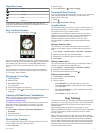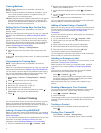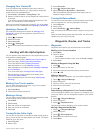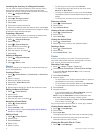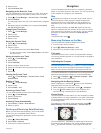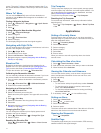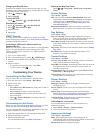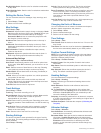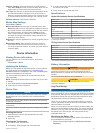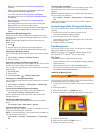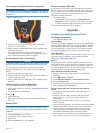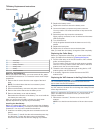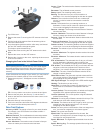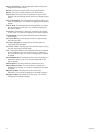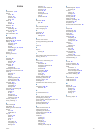
Pressure Trending: Sets how the device records pressure
data. Save Always records all pressure data, which can be
helpful when you are watching for pressure fronts.
Plot Type: Sets the type of data recorded and displayed in the
plot. Records elevation changes over a period of time or
distance, records barometric pressure over a period of time,
or records ambient pressure changes over a period of time.
Calibrate Altimeter: Calibrates the altimeter.
Marine Map Settings
Select Setup > Marine.
Marine Chart Mode: Sets the type of chart the device uses.
Nautical displays various map features in different colors so
the marine POIs are more readable and so the map reflects
the drawing scheme of paper charts. Fishing (requires
marine maps) displays a detailed view of bottom contours
and depth soundings and simplifies map presentation for
optimal use while fishing.
Appearance: Sets the appearance of marine navigation aids on
the map.
Marine Alarm Setup: Sets alarms for when you exceed a
specified drift distance while anchored, when you are off
course by a specified distance, and when you enter water of
a specific depth.
Device Information
Viewing Device Information
You can view the unit ID, software version, and license
agreement.
Select Setup > About.
Updating the Software
Before you can update the handheld device or collar software,
you must connect the handheld device (Connecting the
Handheld Device to a Computer) or the collar (Connecting the
Collar to a Computer) to the computer.
You must update the software on the handheld device and
collar separately.
NOTE: Updating the software does not erase any of your data
or settings.
1
Go to www.garmin.com/products/webupdater.
2
Follow the on-screen instructions.
Device Care
NOTICE
Do not store the device where prolonged exposure to extreme
temperatures can occur, because it can cause permanent
damage.
Never use a hard or sharp object to operate the touch screen,
or damage may result.
Avoid chemical cleaners and solvents that can damage plastic
components.
Secure the weather cap tightly to prevent damage to the USB
port.
Cleaning the Device
1
Wipe the device using a cloth dampened with a mild
detergent solution.
2
Wipe it dry.
Cleaning the Touchscreen
1
Use a soft, clean, lint-free cloth.
2
If necessary, lightly dampen the cloth with water.
3
If using a dampened cloth, turn off the device and disconnect
the device from power.
4
Gently wipe the screen with the cloth.
Specifications
Alpha 100 Handheld Device Specifications
Battery type Rechargeable, replaceable lithium-ion
Battery life Up to 20 hr.
Operating temperature range From -4° to 140°F (from -20° to 60°C)
Charging temperature range From 32° to 104°F (from 0° to 40°C)
Long-term storage temperature
range
From 32° to 77°F (from 0° to 25°C)
VHF wireless range Up to 9 mi.
ANT+ low power wireless range About 10 ft. (3 m)
Water rating IEC 60529 IPX7*
*The device withstands incidental exposure to water of up to
1 m for up to 30 min.
T5 Dog Collar Device Specifications
Battery type Internal rechargeable lithium-ion battery
Battery life From 20 to 40 hr.
Operating temperature range From -4° to 140°F (from -20° to 60°C)
Charging temperature range From 32° to 104°F (from 0° to 40°C)
ANT
®
wireless range Up to 10 m
VHF radio range Up to 9 mi. (14.48 km)
Water rating 1 ATM*
*The device withstands pressure equivalent to a depth of 10 m.
Battery Information
WARNING
This product contains a lithium-ion battery. To prevent the
possibility of personal injury or product damage caused by
battery exposure to extreme heat, store the device out of direct
sunlight.
Do not use a sharp object to remove batteries.
CAUTION
Contact your local waste disposal department to properly
recycle the batteries.
Long-Term Storage
NOTICE
The normal long-term decrease in the charging capacity of
lithium-ion batteries can be accelerated by exposure to elevated
temperatures. Storing a fully charged device in a location with a
temperature outside the long-term storage temperature range
can significantly reduce its recharging capacity.
When you do not plan to use the handheld device for several
months, the battery should be removed. Stored data is not lost
when the battery is removed.
When you do not plan to use the collar for several months, the
battery should be charged to about 50%. The device should be
stored in a cool, dry place with temperatures around the typical
household level. After storage, the collar should be fully
recharged before use.
Maximizing the Battery Life
You can do several things to extend the life of the batteries in
the handheld device and collar.
• Reduce the backlight brightness (Adjusting the Backlight
Brightness).
Device Information 13



